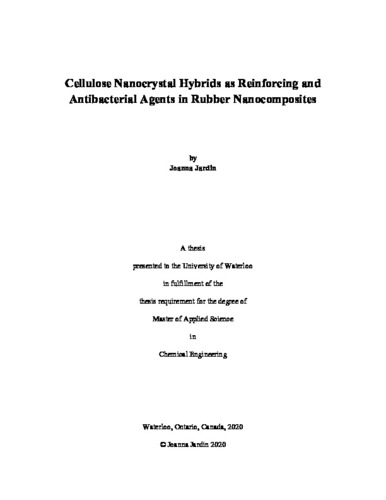| dc.description.abstract | As environmental consciousness increases and fossil fuel feedstocks are depleted, ecofriendly product development is of utmost importance. This thesis describes an in-depth analysis of cellulose nanocrystals (CNC) used as a promising nanofiller derived from cellulosic biomass. Pristine CNC, as well as CNC modified with tannic acid (TA) and silver (Ag) were investigated for reinforcing thin rubber sheets and films. Since polymers are major contributors to waste problems, the work conducted in these projects used natural rubber (NR) as a renewable polymeric material and compared it to synthetic rubbers, styrene butadiene rubber (SBR) and acrylonitrile butadiene rubber (NBR).
In the first part of the project, casted thin sheets of NR and SBR were tested and compared. Percolation of CNC was studied within the rubber matrices, where the tear strength, water permeability, and water absorption increased due to the formation of a continuous network of CNC within the polymer sheets. The rubber nanocomposites were resistant to tear propagation due to increased tortuosity along the tear path brought about by CNC dispersion and the continuous filler network. The CNC reinforcement yielded thin sheets that were stronger and more durable than their non-reinforced counterparts. Additionally, the increased water uptake of the sheets could aid in the biodegradation of the polymer. Thus, CNC was found to be an excellent functional filler in rubber sheets, where its formation of a percolating network significantly improved their properties.
Since CNC was found to be a useful thin film filler material, it was modified into CNC TA Ag to carry silver nanoparticles for antimicrobial functionality. Green chemical processes were used to deposit TA and Ag onto CNC, and optimized to achieve the highest silver nanoparticle content on the CNC. Successful material synthesis was confirmed by Transmission Electron Microscopy (TEM), thermogravimetric analysis (TGA), and Ultraviolet-Visible Spectroscopy (UV-vis) analyses. The CNC-TA-Ag was proven to be effective against both Gram-negative and Gram-positive strains of bacteria, E. coli and S. aureus, respectively. A particular affinity was noted against E. coli, where only 3.2 µg silver/mL was required to completely inhibit microbial growth. Compared to reported literature studies, it was extremely effective against the bacteria, which is likely due to the capability of CNC to stabilize silver nanoparticles in aqueous dispersions. The CNC-TA-Ag was then incorporated into NR and NBR dipped films to emulate the mass production of thin film products. Mechanical tests revealed that CNC-TA-Ag increased the modulus of the rubber nanocomposite films, and effectively increased the tear strength. Preliminary antimicrobial tests showed a promising effect of the CNC-TA-Ag against bacteria when incorporated into neat NR. Based on these results, CNC-TA-Ag may be a useful filler for rubber thin film products, such as sterile antimicrobial gloves. The CNC-TA-Ag filler may also be extended for use in various other polymers or fibres to prepare self-sterilizing coatings and surfaces, paints, packaging materials, bandages, or adhesive nanocomposites. | en |

